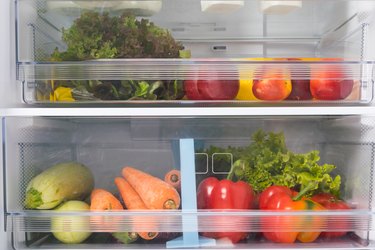
Most refrigerators are equipped with drawers to store fruits and vegetables. While many people believe one drawer should be used for vegetables and one for fruit, in actuality, each drawer has a different humidity setting, and most even allow users to set their own humidity levels. This is because different fruits and vegetables should be stored at different humidity levels, and some fruits and vegetables should be stored away from one another to preserve them for as long as possible.
Humidity for Fruits and Vegetables
Video of the Day
Outside of the crisper drawers, the refrigerator tends to store things at a relatively dry 65 percent humidity. However, most fruits and vegetables prefer higher humidity. If your produce drawers allow you to adjust the settings, then you should know that closing the airflow to a drawer will increase the humidity, while opening it will lower the humidity. In refrigerators that do not allow you to manually control the humidity of the produce drawers, the fruit drawer will typically be less humid than the vegetable drawer.
Video of the Day
In general, vegetables prefer higher humidity than fruits, particularly vegetables that easily wilt, such as leafy greens and green onions. Cauliflower likes a particularly high level of humidity and should be wrapped in a damp paper towel before storing.
Most fruits, including apples, grapes, pears, and cherries, as well as some vegetables, such as bell peppers and summer squash, prefer a middle-of-the-road humidity setting. Citrus fruits prefer lower humidity than other fruits and should ideally be stored outside of the produce drawers altogether.
Produce That Should Be Separated
Crisper drawers can be used for more than just controlling the humidity of your produce. They can also be useful when it comes to separating certain types of produce from others. Foods that produce ethylene, such as apples, peaches, plums, pears, mangos, and cantaloupe, need to be stored apart from foods that are sensitive to ethylene, including broccoli, asparagus, carrots, cauliflower, celery, leafy greens, cucumbers, and peas. Overall, it's best to keep fruits apart from vegetables, as fruit produces more ethylene, and vegetables are more often sensitive to it, but grapes and berries are exceptions, as neither does well with ethylene.
Leave These Produce Products Out
Not all produce should be refrigerated. This is particularly true of tomatoes, which will lose their flavor and become mushy when stored in the refrigerator, and potatoes, onions, and garlic, which are best stored in a cool, dry area outside the fridge, though potatoes should be stored apart from onions since they will make each other go bad more quickly.
Some produce is best left out until it is fully ripened, including avocados, peaches, and pears. Bananas also fall in this group. Though the peel will turn brown when the banana is in the refrigerator, the fruit inside should still be good.